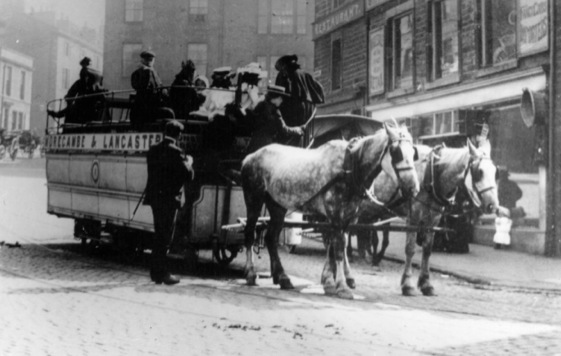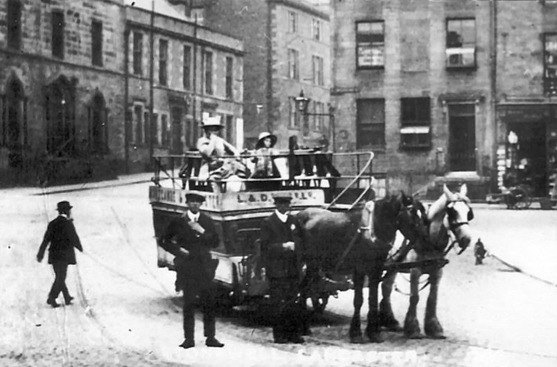Lancaster and District Tramways
History
Lancaster and District Tramways, a standard-gauge, horse-drawn tramway, owned and operated by the Lancaster and District Tramways Company, opened for business on the 2nd August 1890.
It was built on the single-line and passing loop principle, and ran from a terminus in Stonewell on the northern edge of Lancaster city centre, across the Lune, then broadly northwestwards to Morecambe, where it terminated in Market St. The line was 4.3 miles long, and though it came close to the tracks of the Morecambe Tramways Company (from 1908 Morecambe Corporation Tramways) in Morecambe, and Lancaster Corporation Tramways (from 1903 onwards) in Lancaster, no connection was constructed.
The tramway was very dependent on the tourist trade, and with this in mind, it operated tramcars which were perhaps unique in the British Isles, with passengers carried on a raised platform, presumably to allow them to take in the views. It seems to have returned moderate profits until the late-Edwardian era, even turning down a generous offer from Lancaster Corporation in 1903, but from then on the company began to struggle. There were much quicker and cheaper ways to travel between the two towns, and horse traction was more and more viewed as an anachronism, so whilst the company managed to keep its head above water, it was not in a position to renew the track and the tramcars, let alone convert the line to electric traction.
Somehow the company managed to survive the Great War, having struck a deal with a local coach firm, presumably giving them operating rights to supplement the tram services, something the company had itself tried — unsuccessfully — back in 1908. By 1921, the tramway was completely run down, and perhaps more in hope than anticipation, the company offered to sell it to Lancaster and Morecambe Corporations. The move proved unsuccessful, and with motor bus competition in full swing, the company bowed to the inevitable, the last horse tram service running on the 31st December 1921.
Uniforms
Considering that the L&DTCo soldiered on until relatively late for a horse tramway, and was heavily dependent upon tourist revenue — plying its leisurely trade between Lancaster and Morecambe — photographs are surprisingly uncommon. Those that have survived however, show that drivers and conductors — in common with many horse tramways in the UK — wore informal but smart attire: trousers, jackets, waistcoats, shirts and ties. Headgear appears to have largely followed the fashion of the day, predominantly the flat cap. No badges of any kind were worn on either the jackets or the hats.
It is unclear whether inspectors were used by the company, or whether female staff were employed during the Great War. What is however certain is that nothing has survived photographically.
Further reading
For a history of Lancaster's tramways, see: 'The Lancaster and Morecambe Tramways' by S Shuttleworth; Oakwood Press (1976).
Images
Drivers and conductors
One of the rather unusual 'raised seating', open-top single-deck horse cats pictured at the Stonewell Terminus — photo undated, but probably turn of the century. Although it is uncertain if any of those pictured are crew members, what is however clear is that no uniforms are in evidence. Photo courtesy of the Tramways and Light Railway Society, with thanks to David Voice.
A conductor and a driver pose for the cameraman at the Stonewell Terminus in Lancaster — photo undated, but judging by the large flat caps, possibly taken just after the Great War. Both men are wearing smart but informal attire. Photo courtesy of Duncan Holden.